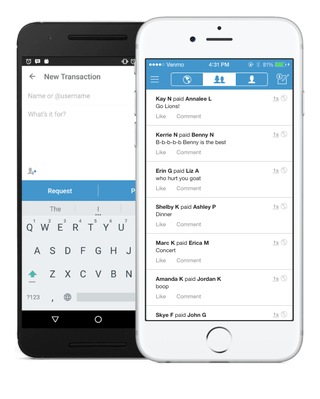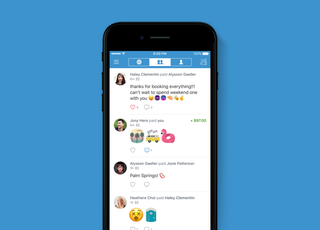What is Venmo Feed or Between You
One of the joys of modern day living is that there's an app for just about anything. Ordering dinner? Head directly to Seamless. Need motivation for your next workout? You can easily find your next (virtual) trainer in the app store. Owe someone money but you aren't a frequent cash carrier? Venmo swoops in to save the day.
Venmo is a quick, easy, and secure way to transfer money between two users. Gone are the days of divvying up bills with cash and—gasp—coins or taking turns "treating" one another to dinner. With Venmo, splitting just about any cost is fair game.
But with this revolutionary way of paying others comes a host of new etiquette questions. Venmo recently surveyed their community of users on some of the most common protocol concerns, and we decided to go even further into the details with etiquette expert (and Venmo's go-to guru) Myka Meier.
More From Town & Country

Read on for Meier's best tips on the ins and outs of using Venmo properly, from when to employ the handy "remind" feature and what to do if someone ghosts you:
How quickly should you request payment via Venmo?
You don't want to seem too eager, but it's important to request payment in a timely manner. The Venmo community set a 48 hour "Venmo lifecycle" standard in a recent survey on etiquette on the app. Most users agreed that it's best practice to send a request for payment within 24 hours of the original transaction. And, if you receive a request, you should do your best to pay it within 24 hours. Overall, the entire transaction should ideally take place within 48 hours.
Meier encourages users to request payments as soon as the charge takes place—for example, if you're at a casual restaurant, Meier said you can even request payment on your phone as you pay the check at the table. If you're at a more formal locale where it would be poor etiquette to have your phone out, you can request or send payment as soon as you leave the restaurant.
Venmo has a "remind" feature that can send a note to a user who has not completed a payment request. When should you use this function?
While it may seem pushy to "remind" another user to fulfill your transaction (AKA pay you back), it's actually a really helpful tool. Venmo users agreed that you can "remind" someone to pay you back within four days of the original request. "It's much more everyday to just sent that remind function," Meier explains. "It kind of takes the awkwardness out of asking for money. So if somebody doesn't pay within four days, I wouldn't wait too much longer because then people really forget." Remember, the remind feature exists for a reason, so don't be afraid to use it.
This content is imported from poll. You may be able to find the same content in another format, or you may be able to find more information, at their web site.
What should you do if someone "ghosts" your Venmo request?
If you send a reminder and your request still goes unanswered as days go by, you might be getting ghosted by the other user. "If they go radio silent and I used the remind function, that's when I'd probably try another form of communication," Meier said. "They could have lost their phone, so I would try a different way, like an email." If the request is still not addressed via text, email, or another form of communication, you'll likely have to bring it up next time you see them in person.
Should you request exact change, or round up or down?
Meier says that requesting the exact amount via Venmo is acceptable, but when in doubt, she tends to round up. "If I owe somebody for a dinner bill, I will round up, but if you're sending a request, you could do so for the exact amount," Meier said. The Venmo community agrees that if you are sharing a detailed breakdown of the overall costs, you can request the exact amount owed.
Is any amount too small to request via Venmo?
Nope. "Most Venmo users said that any request between $1 and $5 would be a normal amount to ask back for," Meier explained. "So there's no amount that's too small." Some users even send small surprise payments under $1, which are transactions called 'penny pokes' by the Venmo community.
When should you split the bill equally versus calculating each person's cost?
This was one of the most commonly asked Venmo etiquette questions among team T&C. The answer isn't exactly black or white—as Meier explains, it depends on the situation. Unless it's a particularly lavish meal or occasion, you can plan on splitting it evenly between everyone. "If your meal costs a little bit different than the next person, I think most people would agree that you would just split it evenly rather instead of tabulate," Meier said.
But if one person had a glass of wine while the rest of the group had a three course meal, then you should calculate each person's cost. This is where Venmo comes in handy: one person can pick up the tab, and each person can send their specific cost overall (with tax and tip included, of course) to whoever paid. Meier also notes that some restaurants will even limit how many cards are allowed to split a specific meal, so Venmo can help divide the cost in those situations as well.
Which privacy setting should you choose for your Venmo transactions?
Given that Venmo has three different privacy settings, "Private," "Friends," or "Public," it can be difficult to decide which one to use for each transaction. And as Meier reveals, the setting you should choose depends on the situation.
When sending a request, it's important to consider the other user. "Think about how the other person may feel with all these settings," Meier said. She adds that if the transaction could offend someone, or if it's extremely personal in nature like giving someone a loan, the "Private" setting will work. As a general rule, Meier advises that "when in doubt, go private," especially if it's something that could cause the other person any kind of discomfort.
The "Public" or "Friend" privacy settings are for slightly more conventional transaction. "The public settings can be everyday, if someone bought you a coffee or splitting an Uber, for example," Meier said. "When in doubt, be more conservative."
This content is imported from poll. You may be able to find the same content in another format, or you may be able to find more information, at their web site.
How do you pick which emoji or message to use when sending a transaction request?
Sometimes a Venmo request has a simple, straightforward message, but other times you can add an emoji (or ten) that perfectly explain the transaction. The most important part of choosing your emoji or message is to consider your audience ahead of time. "Before you choose your emoji, think about who will be seeing this, and where they will see it," Meier said. "It could be your friend's mom, of your friend's boss. Just keep in mind that it is a public forum."
"Some emojis have underlying meanings that are very well known and others don't," Meier added. "If you think you're being secretive about it, you might be surprised how many people would think of other meanings so just use caution."
Is it okay to look at other transactions in your Venmo feed?
One of the defining features of Venmo is the feed, where you can see transactions between two people who are your friends within the app—or you can look at public transactions between people you don't even know. This feed is part of what makes Venmo such a social platform, and it's perfectly okay to scroll through the transaction from time to time.
"People are aware that they're putting it out there if it's public," Meier reveals. "People will even write funny things or use funny emojis because they know others are looking." Meier adds that people check Venmo two to three times per week, and it's not just when they are requesting or fulfilling payments, so you're in good company if you're just in the app to check the feed.
While it can be entertaining to scroll through your feed, Meier warns that it can cause some anxiety among users. "People have social envy over Venmo feeds," Meier said. "I've heard a lot about it, so just be conscious of who is looking."
Is there any protocol that dictates how to discuss payment via Venmo?
When it comes to splitting bills with a group of people, everyone should fully understand how exactly the costs will be split before any money is spent. Meier advises people to discuss fees or payments ahead of time to avoid any awkwardness. If you're going on a trip or a group meal, make sure you figure out ahead of time who is paying and what the estimated costs will be. "There should never be a surprise when you get a request for payment on Venmo," Meier said. "It's good to discuss budget ahead of time."
Maggie Maloney is the Deputy Editor of Oprah Daily. She previously worked at Town & Country, Elle DECOR, and Something Navy.
Source: https://www.townandcountrymag.com/society/money-and-power/a28244165/venmo-etiquette-guide/#:~:text=One%20of%20the%20defining%20features,you%20don't%20even%20know.



0 Response to "What is Venmo Feed or Between You"
Post a Comment